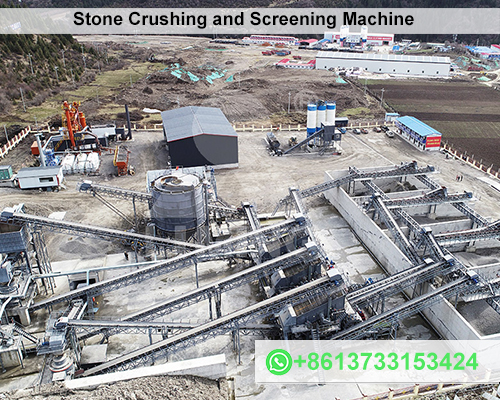What Does a Stone Crushing and Screening Machine Do?
Stone crushing and screening machines play a pivotal role in the aggregate production process, transforming raw materials like rocks, gravel, and sand into usable, graded materials for construction and infrastructure projects. These machines are essential in industries such as mining, quarrying, and construction, where high volumes of materials need to be processed efficiently and effectively.
In this article, we’ll explore the primary functions of a stone crushing and screening machine, the different types available, and their impact on construction projects.

The Role of Stone Crushing and Screening
Stone crushing and screening machines serve two key functions:
- Crushing:The crushing process reduces large chunks of rock into smaller, more manageable pieces. This is typically the first stage of processing and aims to break down oversized material into smaller aggregates that can be used in construction, asphalt, or concrete. The crushing process can be achieved using a variety of machines, each suited to different types of rocks and aggregate sizes.
- Screening:After crushing, the material is then screened to separate it into different grades based on size. Screening involves the use of mesh screens or vibrating sieves to sort the crushed material. This ensures that the final product is uniform and meets the specific requirements of the project, whether that’s fine aggregates for concrete or coarse aggregates for road construction.
Types of Stone Crushing Machines
Stone crushing machines come in a variety of designs, each catering to specific crushing needs. The most common types include:
- Jaw Crusher:These machines use compressive force to break down large chunks of stone. They are ideal for primary crushing, reducing large rocks into smaller, more manageable pieces.
- Cone Crusher:Cone crusher is used for secondary or tertiary crushing. They are particularly effective in producing finer aggregates and are often used when a more uniform material is needed.
- Impact Crusher:These crusher use high-speed impact forces to break down materials. They are commonly used in the production of sand and fine aggregates and are known for their ability to create sharp, angular aggregates.
- Hammer Crusher:These machines use a series of hammers to strike and break the material into smaller pieces. Hammer crusher is typically used for softer materials but can be effective in certain types of stone processing.
Types of Screening Machines
Once the stone has been crushed, it needs to be screened to separate it by size. The types of screening equipment typically used include:
- Vibrating Screens:These are one of the most common types of screening machines, using vibrations to pass materials through mesh screens. The material is sorted into different sizes based on the mesh’s openings.
- Rotary Screens:These screens use a rotating drum to separate materials based on size. They are often used for larger operations with higher throughput requirements.
- Inclined Screens:Similar to vibrating screens, inclined screens are tilted at an angle and use vibration to separate materials, often providing a higher degree of efficiency in material sorting.
Applications of Stone Crushing and Screening Machines
Stone crushing and screening equipment has a broad range of applications in industries such as:
- Construction:The most common application is in the production of aggregates used in road construction, concrete, and asphalt. Crushed stone of varying sizes is used as a base material for roads and as a key ingredient in concrete production.
- Mining:Stone crusher is essential in the mining industry to break down ore into smaller, more manageable sizes for further processing, such as in the extraction of metals.
- Landscaping:Crushed stone and screened aggregates are often used in landscaping for decorative stonework, drainage, and creating hardscapes like paths, patios, and retaining walls.
- Recycling:Crushing and screening machines are also used in recycling operations to process construction and demolition waste, turning old concrete and asphalt into reusable materials.
- Quarrying:In quarries, these machines help extract and process large quantities of stone, sand, and gravel for use in a variety of industries.
The Benefits of Stone Crushing and Screening Machines
- Efficiency:These machines are designed to process large volumes of material quickly, making them ideal for large-scale operations.
- Uniformity:The screening process ensures that the final product is of consistent size, which is crucial for many applications, particularly in construction.
- Cost-Effective:By reducing the need for manual labor and streamlining the production process, these machines help reduce overall costs for aggregate production.
- Environmental Sustainability:Many modern stone crushing and screening machines are designed with energy efficiency and low emissions in mind, making them a more eco-friendly option for aggregate production.
Conclusion
Stone crushing and screening machines are essential tools in the aggregate production process. They break down large rocks and stones into smaller, usable materials and ensure that these materials are properly graded and screened for various construction, mining, and landscaping applications. Their role in industries such as construction, mining, and recycling is invaluable, providing a consistent, efficient, and cost-effective method for producing high-quality aggregates and other materials.









